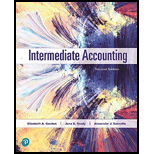
Intermediate Accounting (2nd Edition)
2nd Edition
ISBN: 9780134730370
Author: Elizabeth A. Gordon, Jana S. Raedy, Alexander J. Sannella
Publisher: PEARSON
expand_more
expand_more
format_list_bulleted
Question
Chapter 3, Problem 1JC
1.
To determine
To provide: Two examples of judgments that could have a significant impact on the financial statements.
2.
To determine
To provide: Four examples of estimation uncertainty that might result in a material adjustment in future years.
3.
To determine
Whether the entity must disclose the estimation uncertainty.
Expert Solution & Answer
Want to see the full answer?
Check out a sample textbook solution
Students have asked these similar questions
PLEASE HELP. FILL ALL CELLS FROM LEFT TO RIGHT. Notice, the dropdowns are choosing whether its a debit or credit.
Please do part b please.
Please fill all cells!
Chapter 3 Solutions
Intermediate Accounting (2nd Edition)
Ch. 3 - Prob. 3.1QCh. 3 - Prob. 3.2QCh. 3 - Does U.S. GAAP require that companies disclose...Ch. 3 - Does IFRS require that companies disclose...Ch. 3 - Prob. 3.5QCh. 3 - Does IFRS require that companies disclose their...Ch. 3 - Prob. 3.7QCh. 3 - Prob. 3.8QCh. 3 - Prob. 3.9QCh. 3 - Prob. 3.10Q
Ch. 3 - Prob. 3.11QCh. 3 - What is the Basis for Conclusions and where can...Ch. 3 - Prob. 3.13QCh. 3 - Prob. 3.14QCh. 3 - Prob. 3.1BECh. 3 - Judgment in Accounting for Plant and Equipment....Ch. 3 - Match Each Cognitive Bias Below with its...Ch. 3 - Prob. 3.4BECh. 3 - Prob. 3.5BECh. 3 - Prob. 3.6BECh. 3 - Prob. 3.7BECh. 3 - Codification Research. Referencing Appendix A,...Ch. 3 - Prob. 3.9BECh. 3 - Prob. 3.10BECh. 3 - Exercises E3-1. Accounting Policy Disclosures. To...Ch. 3 - Cognitive Bias. A team of accounting students is...Ch. 3 - Cognitive Bias. A team of accounting students is...Ch. 3 - Authoritative Literature. Provide the reference to...Ch. 3 - Authoritative Literature. Provide the reference to...Ch. 3 - Authoritative Literature. To what entity types...Ch. 3 - Authoritative Literature. How does FASB define...Ch. 3 - Prob. 3.8ECh. 3 - Prob. 1JCCh. 3 - Prob. 2JCCh. 3 - Prob. 1SSCCh. 3 - Surfing the Standards Case 2: Inventory...Ch. 3 - Basis for Conclusions Case 1: Judgment and...Ch. 3 - Basis for Conclusions Case 2: Income Statement or...
Knowledge Booster
Similar questions
- PLEASE HELParrow_forwardOne company might depreciate a new computer over three years while another company might depreciate the same model computer over five years...and both companies are right. True Falsearrow_forwardno chatgpAccumulated Depreciation will appear as a deduction within the section of the balance sheet labeled as Property, Plant and Equipment. True Falsearrow_forward
- No ai Depreciation Expense is shown on the income statement in order to achieve accounting's matching principle. True Falsearrow_forwardno aiOne company might depreciate a new computer over three years while another company might depreciate the same model computer over five years...and both companies are right. True Falsearrow_forwardno ai An asset's useful life is the same as its physical life? True Falsearrow_forward
- no ai Depreciation Expense reflects an allocation of an asset's original cost rather than an allocation based on the economic value that is being consumed. True Falsearrow_forwardThe purpose of depreciation is to have the balance sheet report the current value of an asset. True Falsearrow_forwardDepreciation Expense shown on a company's income statement must be the same amount as the depreciation expense on the company's income tax return. True Falsearrow_forward
arrow_back_ios
SEE MORE QUESTIONS
arrow_forward_ios
Recommended textbooks for you
 Auditing: A Risk Based-Approach to Conducting a Q...AccountingISBN:9781305080577Author:Karla M Johnstone, Audrey A. Gramling, Larry E. RittenbergPublisher:South-Western College Pub
Auditing: A Risk Based-Approach to Conducting a Q...AccountingISBN:9781305080577Author:Karla M Johnstone, Audrey A. Gramling, Larry E. RittenbergPublisher:South-Western College Pub Auditing: A Risk Based-Approach (MindTap Course L...AccountingISBN:9781337619455Author:Karla M Johnstone, Audrey A. Gramling, Larry E. RittenbergPublisher:Cengage Learning
Auditing: A Risk Based-Approach (MindTap Course L...AccountingISBN:9781337619455Author:Karla M Johnstone, Audrey A. Gramling, Larry E. RittenbergPublisher:Cengage Learning Intermediate Accounting: Reporting And AnalysisAccountingISBN:9781337788281Author:James M. Wahlen, Jefferson P. Jones, Donald PagachPublisher:Cengage Learning
Intermediate Accounting: Reporting And AnalysisAccountingISBN:9781337788281Author:James M. Wahlen, Jefferson P. Jones, Donald PagachPublisher:Cengage Learning

Auditing: A Risk Based-Approach to Conducting a Q...
Accounting
ISBN:9781305080577
Author:Karla M Johnstone, Audrey A. Gramling, Larry E. Rittenberg
Publisher:South-Western College Pub

Auditing: A Risk Based-Approach (MindTap Course L...
Accounting
ISBN:9781337619455
Author:Karla M Johnstone, Audrey A. Gramling, Larry E. Rittenberg
Publisher:Cengage Learning

Intermediate Accounting: Reporting And Analysis
Accounting
ISBN:9781337788281
Author:James M. Wahlen, Jefferson P. Jones, Donald Pagach
Publisher:Cengage Learning
